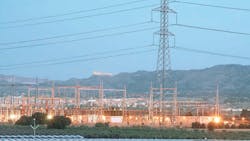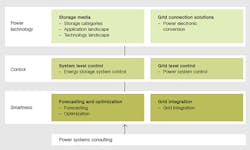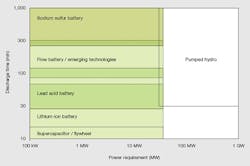Energy storage has been a feature of electricity generation, transmission and distribution for well over a century. The introduction of the rechargeable lead acid battery in the early 1880s was later followed by pumped-hydro storage facilities, in which water was pumped uphill in times of low load so it could be released to drive turbines in times of high load. However, a lot of storage reserve nowadays is provided by running power stations below capacity, to be quickly ramped up on demand – so-called spinning reserve.
Today, a move to "fuel-free" power generation, in the form of wind and solar power, means that the way energy storage is provided needs to adapt accordingly [1,2]. Focus must be placed on the energy storage options that are already available, such as battery and pumped-hydro storage. This is indeed happening, with, for example, a renaissance in pumped hydro [3,4]. Equally, modern batteries can store more energy, deliver more power, last longer and need little or no maintenance. Thanks to developments in power conversion with power electronics, these batteries can be seamlessly integrated into both AC and DC grids [5]. Key technologies For successful energy storage, several other technologies are needed in addition to the storage technology itself. These can be considered as three distinct layers: power technology, control and "smartness." The power technology layer must ensure the safe, stable electrical connection of the energy storage media to the grid, encompassing the storage media, power electronic conversion and the AC grid connection or substation. Next, all elements of the energy storage system and the substation must be controlled locally to ensure safe, precise operation and the ability to execute commands from the grid-level control. With the power technology and control layers in place, the "smartness" layer is needed to determine and schedule the optimum state for each asset in the grid. Binding these three layers together is the end-to-end architecture needed to achieve true energy storage in the grid ➔ 1.
Storage media
The basic function of energy storage in the grid is to allow energy generated at one time to be used at another. The duration for which the energy storage system may need to continuously charge or discharge is perhaps the main difference between the various energy storage applications and has a strong influence on the choice of storage media ➔ 2.
Power electronic conversion
Many energy storage technologies work with DC natively – for example capacitors, supercapacitors and batteries. To connect these to an AC grid, power electronics are needed for the conversion step. In addition, even those energy storage technologies that are natively AC – for example, pumped hydro and flywheels – rely on power electronics to optimally integrate them into an AC grid.
System-level control
Once electrically tied into the grid, an energy storage system must be effectively controlled. A range of control hardware and software is needed to suit all energy storage applications, ranging from distributed control systems for applications such as microgrids, through dedicated power generation control systems for pumped-hydro storage plants.
Grid-level control
Once integrated locally into the grid and effectively controlled, the benefit of an energy storage system can only be felt grid-wide if it is managed in concert with all other generators, loads and other storage systems. The network management system needs to be capable of managing and optimizing assets that are energy-limited as well as power-limited. This optimization must be based on economic as well as technical criteria.
ABB offers all of the solutions to achieve this. The ABB Ventyx Network ManagerTM is a versatile control center solution for managing the grid. The generation management system (GMS) within Network Manager – SCADA (supervisory control and data acquisition)/GMS – enables bulk storage facilities such as pumped hydro or larger battery energy storage facilities to be scheduled and dispatched directly along with all the other power stations in the grid.
Where there are many smaller storage systems and distributed energy resources – such as rooftop solar – distributed throughout the grid, the Ventyx demand response management system (DRMS) can be used to consolidate them into a virtual power plant. The generation management system can then schedule and dispatch this virtual power plant as it would a conventional plant.
Forecasting and optimization
Not only will loads need to be forecast, but as the proportion of intermittent, volatile generation increases, the ability to accurately forecast generation will become essential.
The Ventyx Nostradamus solution is able to take data from many different sources such as weather forecasts, historical renewable generation data and load data, and learn the relationships between them. Having learned these relationships it can then produce rolling forecasts of the state of the grid hours and days ahead.
Technology validation
All of the enabling technologies for energy storage are mature and have been demonstrated and proven in real grid conditions. Indeed, most technologies such as power electronics and control technologies are also widely used elsewhere in the grid today.
Battery energy storage
In 2003, ABB applied battery storage technology to create a spinning reserve for an electric authority in Alaska, in the United States. A power converter system solution, using nickel cadmium batteries, supplies power at 27 MW for 15 minutes and 46 MW for 5 minutes, which allows ample time for local generation to come online.
In 2011, ABB partnered with a Swiss utility to commission the largest battery energy storage system of its kind in Switzerland. This 1 MW lithium-ion battery facility can absorb or discharge power for 15 minutes. It is integrated into the distribution network and is being used to evaluate performance in key areas such as balancing peak loads and intermittent power supply, and the viability of the solution for grid optimization.
Pumped-hydro energy storage
ABB has been developing technologies and providing solutions for the hydroelectric power industry for more than 125 years. In that time, ABB has supplied power and automation equipment for more than 300 hydroelectric power plants all over the world, from small installations of 1 or 2 MW to 10 GW giants.
At a pumped-hydro storage plant in the Swiss Alps, for example, ABB is retrofitting a variable speed drive (VSD) system based on the full converter concept ➔ 3. At 100 MW it is the largest VSD of its kind in the world.
Flywheel energy storage
ABB partnered with an Australian electricity generator, network operator and retailer, and others to build the world's first high-penetration solar diesel hybrid power station. ABB's (flywheel or battery based) Power- StoreTM technology and automation system (M+) enable the power station to achieve consumer use penetration levels of 65 percent per annum and instantaneous penetration levels up to 100 percent.
Grid-level control, forecasting and optimization
The ABB Ventyx Network Manager control center solution has accumulated well over 400 references around the world over the last 25 years. The SCADA/GMS generation management system within Network Manager is therefore a well-proven solution, capable of managing pumped hydro energy storage alongside all other forms of power generation.
In Germany, ABB partnered with a university and an infrastructure and energy services provider in a project to demonstrate the ability of an energy management system to integrate renewables, energy storage, combined heat and power (CHP) systems, and electric vehicles into the grid. ABB's solution involved implementing the Ventyx DRMS to create the virtual power plant and ABB's MicroSCADA Pro to implement local monitoring and control each of the individual resources.
End-to-end architecture
The need for energy storage in the grid has always existed, but in the past has largely been provided by the storage of fuel for fossil-fuel power plants and by keeping a proportion of capacity of power plants in reserve. With a move to wind and solar power, the grid must adapt to store electrical energy after it has been generated.
Each energy storage technology has its own particular pros and cons that need to be fully understood and, once installed, each technology needs to be controllable for the full benefit to be exploited.
With the physical assets and the ability to control them in place, the ability to make the right decisions on how best to manage them becomes critical. This requires accurate forecasts of the state of the grid and of the storage systems themselves. To accomplish this, new levels of intelligence are called for.
Understanding all of these pieces of the puzzle and how they fit together is key to defining an end-to-end architecture for energy storage in the grid.
Stephen Clifford
ABB Smart Grids
Zurich, Switzerland
[email protected]
------------------------------
Further reading
www.abb.com/smartgrids
Schlunegger, H., "Pumping efficiency – A 100 MW converter for the Grimsel 2 pumped-storage plant," ABB Review 2/2014, pp. 42–47.
------------------------------
References
[1] B. Koch, B. Husain, "Smart electricity: Efficient power for a sustainable world," ABB Review 1/2010 pp. 6–9.
[2] A. Oudalov, et al., "Utility scale applications of energy storage," in Energy 2030 Conference, Atlanta, Ga, 2008.
[3] J. J. Simond, et al., "Expected benefits of adjustable speed pumped storage in the European network," in Hydropower into the next century, 1999, pp. 579–585.
[4] J. Svensson, et al., "Improved power system stability and reliability using innovative energy storage technologies," In AC and DC Power Transmission, IET, 2006, pp. 220–224.
[5] C. Rytoft, et al., "Semiconductors Demystified: Part 1, The chips at the heart of the evolving power grid," ABB Review 3/2010 pp. 27–32.



